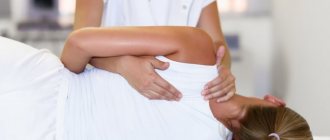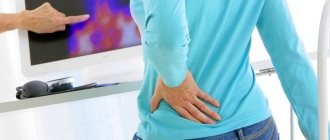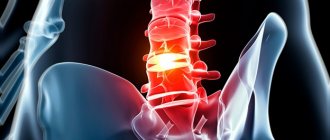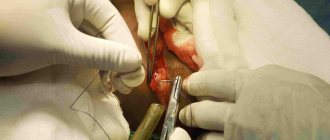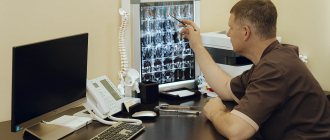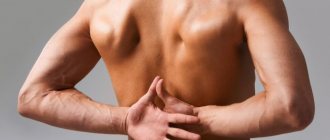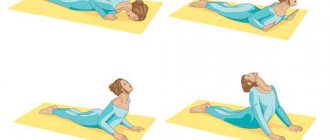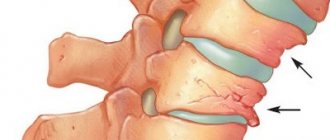Make an appointment by phone: +7 (343) 355-56-57
+7
- About the disease
- How to cure
- Prices
- Sign up
- Specialists
- About the disease
- Prices
- Sign up
Spinal diseases affect 70% of the world's population. Pain reduces social activity and leads to temporary disability. The process can occur in different parts of the spine. Often the cause of ailments is destruction of the lower back, which characterizes lumbosacral radiculitis.
Causes
- degenerative changes: osteochondrosis (protrusion, disc herniation), spondyloarthrosis, vertebral displacement (spondylolisthesis, spondylolysis)
- vertebral compression fractures due to osteoporosis or trauma
- problems with posture (scoliosis, kyphosis, lordosis);
- inflammatory process (spondylodiscitis, spondyloarthritis, rheumatoid arthritis, abscess)
- tumors;
The process can be triggered by: physical activity, hypothermia, lifting (carrying) heavy objects, a sedentary lifestyle and excess weight, pregnancy.
Conservative treatment:
- Rest: avoid activities that cause pain (bending, lifting, twisting, turning or bending backwards. Rest is necessary for acute pain syndrome
- Drug treatment: anti-inflammatory, painkillers, muscle relaxants.
- Physiotherapy. For acute pain syndrome, the use of procedures such as cryotherapy or chivamat is effective. Physiotherapy can reduce pain and inflammation of the spinal structures. After the acute period has stopped, physiotherapy is carried out in courses (ultrasound, electrical stimulation, cold laser, etc.).
- Corseting. The use of a corset is possible in case of acute pain syndrome to reduce the load on the nerve roots, facet joints, and lumbar muscles. But the duration of wearing a corset should be short, since prolonged fixation can lead to muscle atrophy.
- Epidural steroid injections or facet joint injections are used to reduce inflammation and control pain in severe radicular syndrome.
- Manual therapy. Manipulations can improve the mobility of the motor segments of the lumbar spine and relieve excess muscle tension. Using mobilization techniques also helps modulate pain.
- Acupuncture. This method is widely used in the treatment of radicular syndrome in the lumbosacral spine and helps both reduce symptoms in the acute period and is included in the rehabilitation complex.
- Exercise therapy. Exercise includes stretching and strengthening exercises. The exercise program allows you to restore joint mobility, increase range of motion and strengthen your back and abdominal muscles. A good muscle corset allows you to support, stabilize and reduce tension on the spinal joints, discs and reduce the compression effect on the spine. The volume and intensity of exercise should be increased gradually to avoid relapse of symptoms.
- In order to achieve stable remission and restore full functionality of the spine and motor activity, it is necessary for the patient, after completing the course of treatment, to continue independent exercises aimed at stabilizing the spine. The exercise program must be individual.
Symptoms
The main place among the symptoms of lumbosacral radiculitis is pain. Classification by type of pain syndrome:
- 1. Lumbago. This is a reflex spasm of the paravertebral muscles. Characterized by acute pain in the lower back. Often occurs during (after) physical activity.
- 2. Lumboischialgia. This is a reflex spasm of the paravertebral muscles and piriformis muscle (usually on one side) irradiating to the gluteal region.
- 3. Lumbar radiculopathy: pain in the lumbar region with irradiation along the affected radicular nerve, sensory and motor disturbances in the area of nerve intervention. The upper segments 1-3 are the perineum, genitals, 4-5 and 1 cross are the lower limbs. In the chronic course of the disease, sensory and motor impairments may no longer recover, a chronic pain syndrome may form, the most dangerous complication is spinal canal stenosis with pressure on the spinal cord or spinal cord roots (cauda equina). Paresis of the lower extremities and pelvic dysfunction develop. This complication requires an emergency consultation with a neurosurgeon and a solution to the issue of surgical intervention and decompression of the spinal canal.
Radiculitis. Treatment, prevention
Radiculitis is a fairly common disease of the peripheral nervous system. The disease is based on damage to bundles of nerve fibers, the so-called nerve roots extending from the spinal cord. Any damage or inflammation is radiculitis.
Causes of radiculitis
The main reliably established reasons are:
- disc herniation in one of the parts of the spine - narrowing of the spinal canal - narrowing of the canal where the nerve root is located - trauma - tumor - degeneration of the vertebral discs - osteophytes (a bone spur, a growth that is not normal for a healthy skeleton, is a full-fledged bone mass that is formed in as a result of the protective reaction of the spine to overload) An attack of radiculitis can be triggered by metabolic disorders, infections, heavy lifting, sleeping in an uncomfortable position, or awkward movement. Those at risk of developing radiculitis include professional athletes, people engaged in heavy physical labor, summer residents, as well as people leading a sedentary lifestyle.
Types of radiculitis
Most often, the disease develops acutely and for the most part becomes chronic with temporary exacerbations. Depending on the location, radiculitis is divided into four types.
• Lumbosacral radiculitis, characterized by damage to the roots of the sacral spine. In this case, pain occurs and intensifies with movement, bending, and walking. This is the case when you bend down to tie your shoelaces, but you can no longer straighten up, because it causes severe pain. This case of radiculitis is most often encountered in medical practice.
• Cervicobrachial, characterized by pain in the neck, shoulders, and arms. The pain intensifies when moving the arms or head, and also when coughing.
• Cervical sciatica will make you suffer from pain in the neck and back of the head. Head movements increase the pain.
• Thoracic radiculitis. Of all the types of radiculitis, this is the rarest. Accompanied by pain in the intercostal spaces.
Still, the common and main symptom of radiculitis for any part of the spine is shooting pain (as from an electric shock) at the site of the lesion along the nerve.
Later, numbness and tingling may appear at the site of the lesion. Pain and temperature sensitivity may decrease or be completely absent. Muscle weakness and vascular disorders are observed.
Treatment methods for radiculitis
Treatment for sciatica depends on the severity of symptoms. In the acute period, strict bed rest (preferably on a hard bed) and the use of anti-inflammatory and painkillers are necessary.
It is better to treat radiculitis comprehensively, combining traditional medicine and medical practices with folk remedies. In general, the treatment process is carried out with the help of medications, physiotherapy, manual therapy, acupuncture, exercise therapy and folk remedies.
In especially severe cases, with a pronounced clinical picture or in the presence of persistent pain, surgical intervention is required.
Treatment of radiculitis with medication
The essence of treating radiculitis with medications is to relieve muscle spasms and eliminate pain. Unfortunately, drug treatment for radiculitis is temporary. To consolidate the results of treatment, it is necessary to undergo a course of exercise therapy and take advantage of the possibilities of physiotherapy, manual therapy or acupuncture.
In the treatment of radiculitis, narcotic analgesics are used medicinally - muscle relaxants (metacarbomal and cyclobenzaprine). Simple analgesics, such as paracetamol, panadol, aspirin, ifuprofen (nurofen), pentalgin, baralgin, will also help relieve pain.
Now, more about non-drug treatment of radiculitis. Physiotherapy helps improve blood circulation in tissues,
adjacent to the root, improve the conduction of nerve impulses along nerve fibers, and also reduce pain.
There are many techniques for treating sciatica using physical therapy, such as ultrasound, electrophoresis and dynamic current. Massage and manual therapy can relieve muscle spasms and blocks, which also helps reduce pain.
Acupuncture is designed to restore the process of conducting impulses along nerve fibers by influencing biologically active points of the body.
Exercise therapy is designed to help restore the natural biomechanics of the spine and normalize movements. Sometimes, with the help of exercises, by redistributing the load on the muscles, it is possible to relieve compression of the spine. Exercises help increase the elasticity of muscles and ligaments, and can also stop degenerative processes in the spine, which allows you to increase range of motion.
Regular exercise is a good prevention of relapses of radiculitis. Exercises on simulators give the greatest effect.
Aerotherapy is a complex effect of hardening, swimming, sun treatment and air exposure on the patient’s body. Aerotherapy gives good results in the treatment of radiculitis.
Air procedures are the simplest form of hardening. Air baths have a chemical, mechanical and temperature effect on the body. The sea and forest air are especially healing. For the greatest effect, it is better to take air baths undressed.
The beneficial effects of solar procedures will only occur if they are carried out correctly. The average course of treatment is 20 - 40 procedures, with a break every seventh day. It is recommended to sunbathe in the morning, in the shade of greenery, and no more than two hours a day.
If there is not enough sun, especially in the northern regions, you can drink a decoction of St. John's wort before the procedure, which will increase the effect of sunlight on the body. Sun therapy should be stopped if one of the symptoms appears: increased heart rate, dizziness, loss of appetite. In any case, you should not sunbathe until you get burns or sunstroke.
Contrast showers and bathing are considered useful procedures for radiculitis. Contrast shower stimulates skin cells, blood vessels and nerves
endings, which is important for patients with radiculitis. In addition, a contrast shower has a hardening effect.
Swimming will have the greatest effect in a natural body of water, where the same temperature of water and air is not maintained throughout the year. In addition to the strengthening effect on the back muscles from swimming, here you can also get all the benefits of hardening.
Diet for radiculitis
Everyone knows that food greatly affects the condition of the body. To prevent attacks of radiculitis, it is recommended to adhere to a diet. You need to eat little by little 4 - 5 times a day.
The diet should contain a lot of fiber, vegetables and fruits are healthy. Tomatoes, cucumbers, radishes, carrots, and cabbage are especially useful. As for fruits, you should often eat bananas, dried apricots, prunes, persimmons, pomegranates and citrus fruits.
Black elderberry is very useful for radiculitis. In addition, you need to give up fatty meat, strong meat broths, coffee, alcohol, carbonated drinks, salty, smoked, and spices.
It is unhealthy to eat flour and sweets. You need to eat fish 2-3 times a week. Porridges are healthy, especially oatmeal, rice and buckwheat. They recommend eating peas, beans, and corn.
Prevention of radiculitis
In order for painful attacks of radiculitis to be as rare as possible, it is necessary to engage in the prevention of radiculitis. After all, it is easier to prevent illness than to suffer from piercing pain.
Prevention of radiculitis consists of several important areas.
* Do not forget to prevent osteochondrosis
* Prevent pathologies of the spinal cord and spinal column
* Maintain posture (keep your back correct)
* Treat infectious and colds in a timely manner
* Avoid hypothermia.
* Avoid prolonged positions in uncomfortable positions, prolonged static loads, heavy lifting and very sudden movements.
* Avoid beds that are too soft, where the spine is in the wrong position all night and the back does not rest (it is best to have an orthopedic mattress, or at least any good hard mattress)
* Do not forget to do gymnastics, including therapeutic exercises. Correct physical activity is of great importance in preventing the disease and treating radiculitis. We must remember that moderate physical exercise relieves tension from the muscles, trains the muscular frame and strengthens the spine.
Complex exercise therapy for osteochondrosis of the cervical spine (non-acute forms): 1. Warm-up Warm-up is a normal walk on the full foot, and then on the toes and heels. Moreover, it is necessary to walk until a feeling of warmth appears. 2. Relaxation of the cervical spine You need to stand up straight, with your arms hanging freely along your body. Then you need to tense your arms and hold the tension for 30 seconds, while you need to straighten your back and lower your shoulders and shoulder blades. Then the pressure should be released and the arms should be allowed to swing freely. 3. Swing your arms back You need to stand straight, while your body should be lowered parallel to the floor. Then you need to stretch your arms to the sides, but you don’t need to stretch your shoulders towards your ears, you should try to move the top of your head forward, while at the same time lowering your shoulder blades towards the spine. You have to imagine that your shoulder blades are your wings. Next, you should make a “swing” - forcefully pull the shoulder blades towards the spine, during this movement the straight arms move slightly back. You should not move your arms due to inertia, you should try to work with your back muscles. Exercise therapy complex for osteochondrosis of the thoracic spine: 1. Warm-up Warm-up for this exercise therapy complex is the same as for exercise therapy for cervical osteochondrosis. Exercise “Boat” To perform this exercise, you need to lie on your stomach, then lift your chest off the floor, and your arms should form perpendicular to your back. Then you need to try to move the shoulder blades one towards the other, with sharp angles reaching towards the spine. At the same time, you should try to move your hands back a little. It is necessary to feel the tension only in the muscles of the back, and not in the arms.
LH complex (therapeutic gymnastics) for osteochondrosis of the lumbar spine: 1. Warm-up The warm-up in this exercise therapy complex is similar to the warm-up in the previous complexes. 2. Tilting the pelvis You need to stand up straight, while your knees and hips should be relaxed, and your arms should not be strained. Next, you need to tighten your buttocks, as if tilting your pelvis inward. The goal of this exercise is a completely flat lower back in profile. This movement must be performed slowly, vertebra by vertebra. 3. Rotation of the pelvis It is necessary to perform movements that allow you to twist the pelvis to the right and left, while gradually pushing forward either the right or the left thigh. This movement is similar to an element from oriental dances. When performing this exercise, the upper body should be fixed in a stable position, the chest should swing, but you should not bend forward and backward at the waist. 4. Exercise “Cat-Cow” To perform this exercise, you need to get on all fours so that your thighs are strictly perpendicular to the floor and your palms are under your shoulders. Then you should relax your muscles and bend your lower back down, while stretching the neck area and moving your head back. In this position, you need to stretch for 20 seconds, and then perform the opposite movement, arching your lower back upward, and aim your thoracic spine towards your hips. All exercises of these exercise therapy complexes for osteochondrosis must be performed regularly, systematically, but before starting classes, you should consult a doctor.
Information provided based on publications of the NewsMedical website, Russia
Physiotherapist FTO Aleinikova N.E.
Prevention
The development of radicular syndrome in the lumbosacral spine can be prevented. To reduce the likelihood of developing this condition you should:
- Practice good posture while sitting and standing, including while driving.
- Use proper body mechanics when lifting, pushing, pulling, or performing any activity that places additional stress on the spine.
- Maintain a healthy weight. This will reduce the load on the spine.
- No smoking.
- Discuss your profession with a physical therapy doctor, who can analyze work movements and suggest measures to reduce the risk of injury.
- Muscles should be strong and elastic. It is necessary to consistently maintain a sufficient level of physical activity.
Risk factors
Those most at risk of developing radiculitis are:
- representatives of professions characterized by high physical activity (athletes, miners, loaders);
- specialists whose work involves standing in one place for a long time (dentists, surgeons, machine operators, salespeople, managers, etc.);
- office workers who have to sit for long periods of time;
- drivers whose spine is exposed to prolonged vibration, etc.
Treatment
Modern medicine uses an integrated approach to the treatment of radiculitis. Appointed:
- Medications - muscle relaxants, decongestants and non-steroidal anti-inflammatory drugs to relieve muscle spasms, swelling, pain, B vitamins and other medications.
- Non-drug means – physiotherapeutic methods: ultrasound therapy, electrophoresis, therapeutic massage, exercise therapy, acupuncture and other procedures.
In case of an acute attack, bed rest is recommended for the first couple of days; in the future, it is advisable for the patient to wear a corset or a special belt that supports the back. It is important to strengthen the back muscles with therapeutic exercises. There are exercises that can be done even during exacerbation of radiculitis.
Treating it yourself can be dangerous - warming up the lower back, which many people are accustomed to, can only worsen back pain if the cause is not sciatica, but other diseases for which heat is contraindicated.
The optimal program of action will be drawn up by a neurologist. You can make an appointment by phone: 8 (495) 126-14-75.
Symptoms of inflammation of the sciatic nerve
- Swelling at the site of inflammation
- Redness of the skin near the nerve
- Sharp shooting pains in the lower extremities. Usually the pain is mobile - goes from top to bottom
- Discomfort in the buttocks, thighs, lower legs or lower back
- Difficulty in movement - a person cannot straighten up. In this case, it is better to remain tilted, so the pain will be felt less
- Increased body temperature. Most often it does not exceed 38°C
- Weakness of muscles
Inflammation affects not only external organs, but also internal ones. The functioning of the genitourinary and digestive systems is disrupted. For example, involuntary urination may occur. In men, such injury leads to decreased libido.
If you ignore the symptoms of inflammation, they may disappear over time. However, they will quickly return and get worse if left untreated.
Diagnosis of lumbosacral radiculitis
Although the most common causes of lumbar sciatica are herniated discs and chronic degenerative diseases of the spine, it is important to be aware of other factors that influence the development of sciatica, including neoplasms and infections. Initial evaluation usually focuses on localizing the lumbosacral radiculopathy and excluding disorders that may produce irreversible neurological syndromes.
First of all, when diagnosing lumbar radiculitis, attention is paid to the presence of characteristic complaints. Next, the doctor performs an examination to determine muscle strength and range of motion in the innervated areas. When assessing the neurological status, attention is paid to the presence of certain pathological reflexes of symptoms (Lasega, Bekhterev, Neri, Dezherina).
Among the instrumental research methods, magnetic resonance imaging of the lumbar region is used, which will clearly determine compression of the spinal roots, the presence of hernias and protrusions, degenerative changes in the vertebrae and facet joints.
If you have any questions, ask our specialist! Ask a Question
Development of the disease
It is difficult to determine the specific cause of lumbar radiculitis. The disease is associated with various pathologies - from injuries to age-related changes in the spine. There are several factors that are identified in patients with the disease:
- Dystrophic and degenerative processes in the intervertebral discs, which occur in people over 45 years of age. They lead to osteochondrosis and hernias that compress the nerve roots.
- Traumatic injuries to the spine (bruises, blows, accidents).
- Acute infectious diseases of viral and bacterial causes.
- Overweight, obesity.
Experienced diagnosticians always identify the cause of lumbar radiculitis. This is necessary to select effective methods of treatment and recovery of the patient.
Causes of radiculitis
The cause of the development of radiculitis is pathological processes occurring in the spine, namely:
- Degenerative-dystrophic processes - osteochondrosis and its complications: protrusion and herniation of intervertebral discs
- Malformations of the musculoskeletal system, accompanied by changes in muscle tone
- Poor posture, curvature of the spine - scoliosis
- Incorrect distribution of physical stress on the spinal column during a person’s professional activity (when driving a car, office workers and loaders - when they stay in one position for a long time, loaders)
- A sedentary lifestyle, in which disturbances in the blood supply to the muscles of the lumbar region gradually increase
- Improper drinking regime throughout the day and for several months
- Deficiency of vitamins and minerals leads to osteoporosis and trophic lesions of the nerve fiber
- Tuberculosis, osteomyelitis, chronic syphilis and other types of infectious lesions of the spinal cord
- Regular injuries to the vertebrae and surrounding soft tissues (impacts, sharp twists, compression when jumping, sprains of the ligaments)
- Overweight with obesity of 1-2 degrees and the presence of bad habits such as smoking, abuse of tea, coffee and alcoholic beverages
What is sciatica
Radiculitis (radiculopathy, radicular syndrome) is an inflammatory lesion of the spinal roots, accompanied by severe pain.
In the public consciousness, this disease is inextricably linked with old age, which is generally true: according to statistics, every eighth person from the older age group suffers from acute or chronic radiculitis. However, people aged 30+ are not immune from this disease. We largely owe this “rejuvenation” of the disease to the increase in the number of office “sedentary” professions.
Pathological changes can occur in one spinal root or in several simultaneously.
1 Diagnosis and treatment of radiculitis
2 Diagnosis and treatment of radiculitis
3 Diagnosis and treatment of radiculitis
Rehabilitation period
The recovery period after discectomy for lumbosacral radiculitis includes three periods. In the first week, the patient can gradually rise in bed, but it is strictly forbidden to sit. The duration of stay in a vertical position should not exceed 15 minutes. In addition, you should not lie on your stomach. You should always wear a corset for the lumbosacral region.
The patient spends the entire first week in the hospital. He may be prescribed antibacterial drugs, NSAIDs, hormonal and other drugs. On days 7-9, the sutures are removed and the patient is discharged home. Its transportation is carried out in a lying position.
In the first month, it is especially important to follow all doctor’s instructions. In order to support the lumbosacral region, the person continues to wear a special corset. Simple exercises are performed daily. Walking and being in nature is important. Usually, after 1.5-2 months, the sick leave is closed and the person returns to “normal” life, taking into account medical recommendations.
Diagnosis for lumbar radiculitis
Doctors at Dr. Dlin’s clinic practice a comprehensive approach to examining patients. They use classical diagnostic methods and apply osteopathic examination. To select therapy, it is necessary to establish the specific cause of the disorders. Osteopathy is based on manual influence on the human body without the use of auxiliary means.
Studying muscle tone and the condition of the musculoskeletal system reveals minimal changes in the functioning of internal organs and the nervous system. Additionally, laboratory and instrumental studies are carried out. They depend on complaints and the results of osteopathic diagnostics. For example, computed tomography or magnetic resonance imaging is used to confirm hernias.
Surgery
Surgical methods for the treatment of radicular syndrome in the lumbosacral spine are necessary in cases where there is resistance to conservative treatment or there are symptoms indicating severe compression of the root such as:
- Increased radicular pain
- Signs of increased root irritation
- Muscle weakness and atrophy
- Incontinence or bowel and bladder dysfunction
As symptoms worsen, surgery may be indicated to relieve compression and remove degenerative tissue that is affecting the root. Surgical treatments for radicular syndrome in the lumbosacral spine will depend on which structure is causing the compression. Typically, these treatments involve some way to decompress the spine or stabilize the spine.
Some surgical procedures used to treat lumbar radiculopathy are:
- Fixation of vertebrae (spinal fusion - anterior and posterior)
- Lumbar laminectomy
- Lumbar microdiscectomy
- Laminotomy
- Transforaminal lumbar
intercorporeal fusion - Cage implantation
- Correction of deformity
Treatment of radiculitis at home using the NANOPLAST forte therapeutic patch
used in the therapeutic treatment of radiculitis , such as NSAIDs, muscle relaxants, etc., certainly alleviate the patient’s condition, but with prolonged use they can cause harm to the body. And for some gastrointestinal diseases, many drugs are generally contraindicated.
But now it is possible to minimize side effects and at the same time increase the effectiveness of sciatica treatment. A new generation drug can help with this - the pain-relieving anti-inflammatory medical patch NANOPLAST forte .
In the treatment of radiculitis, the therapeutic plaster NANOPLAST forte in many cases shows very good results:
- helps relieve pain and inflammation,
- improve blood circulation in the affected area, which ensures active restoration of damaged tissues;
- makes it possible to reduce the dose of painkillers and anti-inflammatory drugs, and in some cases, cancel them altogether.
For radiculitis , the therapeutic plaster NANOPLAST forte is applied to the neck, cervico-brachial region, lower back or intercostal area - depending on the location of the pain. It is usually recommended to use the patch in the morning for 12 hours, but it can also be used at night. The duration of the course of treatment of radiculitis with a medicinal patch is from 9 days
High efficiency, absence of harmful side effects, long-term (up to 12 hours!) therapeutic effects, ease of use and affordable price make NANOPLAST forte the drug of choice in the treatment of radiculitis.
Read more about NANOPLAST forte
Forecast
In most cases, it is possible to treat radicular syndrome in the lumbosacral spine conservatively (without surgical intervention) and restore ability to work. The duration of treatment may vary from 4 to 12 weeks depending on the severity of symptoms. Patients should continue to perform exercises at home to improve their posture, stretching, strengthening, and stabilization. These exercises are necessary to treat the condition causing radicular syndrome.
Causes and types of radiculitis (radiculopathy)
The anatomical causes of radiculitis (radiculopathy) are dysfunction of one of the roots. When compression of the root occurs, symptoms appear on the affected side and in the innervation zone. Typically, when symptoms appear, such as pain in the neck or lower back, radiating to the arm or leg, numbness or muscle weakness in the extremities, one should suspect that there is compression and irritation of the root exiting the spinal cord. Most often, the spine is affected by the discs and sometimes the vertebrae themselves. For example, when a disc ruptures, it bulges into the spinal canal and impacts the root. Bone structures can also affect the root through degeneration or bone growths (osteophytes). Patients with radiculitis (radiculopathy) face various symptoms: wandering pain from the neck to the arms and from the lower back to the legs, various disturbances or changes in sensitivity (numbness, tingling, burning in the limbs), decreased muscle strength in certain muscles. Main causes of radiculitis (radiculopathy)
- Disc herniation in the lumbar, cervical or thoracic spine.
- Spinal canal stenosis
- Foraminal stenosis (narrowing of the canal through which the root passes)
- Disc degeneration
- Injury
- Presence of osteophytes, tumors
Depending on the location of radiculitis (radiculopathies), cervical, thoracic or lumbar radiculitis is distinguished.
Why is it important to treat sciatica?
If radiculitis is not treated in time, it can develop into a chronic form. Then any, even minor, negative impacts (a cold back, lifting a heavy load), as well as an infection, careless movement, or even nervous stress, can trigger an attack of radiculitis. But what is even more dangerous is that the further development of the disease that causes radiculitis (osteochondrosis, spinal stenosis, etc.) can lead to very serious consequences, including disability. Thus, complete prolapse of a disc herniation in the cauda equina region (lower part of the lumbar spine) leads to paralysis of the legs and feet, dysfunction of the pelvic organs.
Muscle spasms, which are also often the cause of radiculitis, can also cause serious consequences. They impair the nutrition of the joints of the spine, which leads to its destruction, and therefore also require treatment. If an acute attack of radiculitis continues for several days, and the pain is accompanied by sensations of numbness, burning, and sipping in the limbs, you should immediately consult a doctor.
The diagnosis of radiculitis is made by a neurologist based on a detailed examination of the patient.
How does radiculitis manifest?
Lumbar radiculitis has characteristic symptoms, which help to make the correct diagnosis. As a rule, osteochondrosis occurs for a long time without any complaints. This period can last from several months to several years. With stress, heavy physical activity, acute infections and other factors, the pathology worsens and symptoms appear:
- Pain in the buttocks and lower back. They are sharp, pulling in nature, and can spread down the leg or along the back. The pain intensifies when bending over and lifting heavy objects.
- Sensory disturbances along the leg. This is due to loss of function of a specific spinal root.
- Muscle weakness, which leads to gait disturbances, up to complete immobility of the leg.
Without treatment, the symptoms of radiculitis progress, the pain intensifies, and the discomfort becomes unbearable. Compression of the spinal nerve root requires consultation with a doctor to select treatment.
Diagnostics
A neurologist diagnoses radiculitis. He carefully analyzes the patient’s complaints, performs palpation of the body along the nerve trunks and a series of neurological tests. A characteristic symptom is Lasegue’s symptom (exacerbation of pain when raising the leg while lying down) and others.
To determine the cause of radiculitis, clarify the location of its occurrence, and distinguish it from other diseases with similar symptoms, the following are prescribed:
- X-ray – to assess the deformation of vertebral structures.
- ECG - to exclude cardiovascular pathologies.
- Electromyography is an assessment of the passage of nerve impulses.
- MRI – assessment of soft and hard structures of the spine, the degree of nerve pinching.
- CT scan – examination of the spine.
- Blood and urine tests.
The list of examinations is prescribed individually for each patient.

